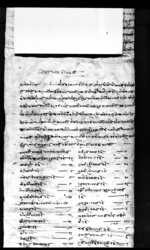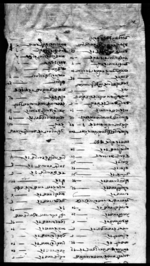A copy of a stone inscription listing the rent paid by shops at the Ḍabalī of Asana Ṭol [VS 1961]
ID: K_0242_0030
Edited and
translated by Simon Cubelic
in collaboration with
Manik Bajracharya and Rajan Khatiwoda
Created: 2015-05-15;
Last modified: 2017-10-16
For the metadata of the document, click here
The accompanying edition, translation/synopsis and/or commentary are available under the terms of the Creative Commons Attribution-ShareAlike 4.0 International License
Abstract
This is a copy of a stone inscription listing the rent paid to the Annapūrṇā Guṭhī by 43 shops at the market square of Asana Ṭola, together with an accounting of how the rent is spent by the guṭhī.Diplomatic edition
[1r pt. 1]
1⟪२⟫1⟪सिलापत्रकोनकल⟫¯¯¯¯¯1आगेअसंटोलकोगुठीभीत्रकाजगाहीटीमंगलपुर्वपुलुकीसिकोसत्तल्देषीदक्षी2णगरूधकाकरमासिंस्याहुलेकपडापसलराष्यादेषीपछींअसोकराजाकोरानीलेवनाया
3कोसतलदेषीउत्तरपनीचारकील्लाभीत्रगुठरैकरतपसिलवमोजिंकापसल४३कोथीती
4वाधीवक्स्यावमोजिंघट्वढनगर्नुवालदीयासम्मनउठाउनुवालनदियाउठाइपजनी
5गर्नुयोसीलापत्रमालेष्यावमोजिंकांगरीश्री५सरकारकोजयेमनाऊलेष्यावमोजिम
6कोजोलोभानीपापानीगरीघटाउलापंचमाहापातकलाग्लाजस्लेसीलापत्रमाले
7ष्यावमोजिंकोकांचलाउलाश्रीगंगाजीनहायाकोपुण्यण्येकफलहोलासागपात
5पातफुलयतिवाहेकअसोकराजाकारानीलेवनायाकोसतलमा१वर्षको५फेराछाडी
9दीनुरभोजषानुलाइजस्लेनछोडलापंचमाहापातकलाग्ला¯¯¯¯
10
[table]
| उतरपटीसतलकेपसलकातपसिलवमोजिंकोवालनेवारहलुवाइ१के | १५ | मनीरामपसल१के | ८ | |
| सालमी१के | १२ | तेलकोपसल१के | १० | |
| केरीमलसी१के | ८ | राजवीरकोपसल१के | १० | |
| नापेचादेवलभाजुरा१के | ८ | जुधवीरकोपसल१के | ६ | |
| वीद्रसिंपसले१के | ८ | भाडोकेपसल१के | १० | |
| जेनसिंपसल१के | २० | हलुवाइकापसल१के | १६ | |
| कास्पीलीपसल१के | १० | पछींप्रमीकापसलरुद्रनारानपसल ३के | १५ | |
| पुर्वलापादीकापसलकोनाकोगरुध कापसल१के | ७ | सुषजुकापसल२के | ६ | |
| भीनरसिंपसल१के | १२ | अजुवीरपसल१के | ४ | |
| धीणारानपसल१के | १२ | माइकादेवलपसलजीवलक्ष्मी धं२के | ११॥ | |
| पुनीमाध१के | ७॥ | चकछत्रनारान२के | ८ | |
| फटंचा१के | १२ | दसरथवषामान२के | ६ | |
| मेनकर१के | ७॥ | रामनरसिंदेवनारान२के | ५ | |
| फवंजारअयातनकाइ | २॥ |
[1r pt. 2]
[table]
| सराफीपसल१०के | २० | |||
| पसल१चीराकवहादुर |
28 ¯¯¯¯¯ ¯¯¯¯¯ ¯¯¯¯¯ ¯¯¯¯¯
[table]
| श्री५सरकारमादीनुपर्न्यापैसारुपैञा | १०० | गुठीयारजना५केपुजागरीभोजषानु केषर्च | १२॥ | |
| नीत्येपुजागर्न्यासीधानन्दके३ | २५ | तहसिलदारटहलुवा१के | ११ | |
| श्रीनारायणपुजासराजामलेकेषर्चके | १९ | नेवारकोकुमारीषुवाउनाके | ३॥ | |
| माइकोगहनावनाउन्यके | ३० | देवलकासवैपसलगर्न्याजना२७सी सीधीकेपैरू | १२ | |
| कुमारीकुमार६केषर्च | ८ | व्राह्मणजुपालेजका५केपाठकोद क्षीणा | २// | |
| नान्येश्वरीकापजनीपाकेभोजषीलाउ न्याके | ८ | यस्कामकोगुठीयारजना | ५ | |
| देवलसीघारनाकेसिंधुरकोपसलज्या लालिनके | १६ | ज्यापुनेवारी | १ | |
| वडादसैमापुजाकेषर्चवोका३केरुपैञा | १० | दठेकोइन्द्रश्रेष्ठ | १ | |
| पुजादीपपालाकेषर्च | ५ | असनटोलकोराजावेरश्रेष्ठ | १ | |
| चैतेदसैमापुजावोकाषर्चके | १० | कमलाछीकोजुधवीर | १ | |
| कुसल्ल्या[?]इ१के | ८२ | असंवाहालकोधंवीरकसाल | १ | |
| आंदानीभयासम्मगुठीचलाउनुराजा वुझाउनुयतिहुकुमभयाकोहो |
Translation
[1r]
3
A copy of the stone inscription (śīlāpatra)
Āge: No one shall deviate (ghaṭbaḍh) from the rules laid down according to the guṭharaikara for the 43 shops on land belonging to the guṭhī of --- (i.e., Annapūrṇā) at Asana Ṭola, within the following four boundaries: east from Hīṭīmaṅgala, south from the sattala of Pulukīsī1 , west from the abode of Garuḍa where Siṃ Sāhule’s cloth shop is located, and north from the sattala built by King Aśoka’s queen. They [the shopkeepers of the 43 shops] shall not be expelled as long as they pay their rent. If they do not pay their rent, they shall be expelled and [their shops] shall be reassigned (pajanī). You shall carry out the tasks written down in the stone inscription and celebrate His Majesty’s victories. Whoever out of greed (lobhānī pāpānī) does not fulfill the tasks inscribed will be guilty under [the provisions pertaining to] the five grievous sins (pañcamahāpātaka)2 . On contrary, whoever carries out the tasks as inscribed on the stone-slab, will obtain the merit of taking a bath in Venerable Gaṅgā. Apart from the vegetable and fruit [shops], you shall five times a year leave the sattala built by King Aśoka’s queen for the feasts. Whoever does not leave [for these occasions] will be guilty under [the provisions pertaining to] the five grievous sins.
The rent for the shops at the sattala towards the north is as follows:
[table]
| for one Newar sweet shop | 15 | for one shop of Manirāma | 8 | |
| for one shop of sālamī | 12 | for one oil-shop | 10 | |
| for 1 Kerīmalsī | 8 | for one shop of Rājavīra | 10 | |
| for 1 [shop] of Bhājurā at Nāpecādevala | 8 | for 1 shop of Juddhavīra | 6 | |
| for 1 shop of Vīdra Siṃ | 8 | for 1 utensils shop | 10 | |
| for 1 shop of Jena Siṃ | 20 | for 1 sweet shop | 16 | |
| for 1 shop of Kāspīlī | 10 | for 3 [shops] in the west of the shops of Pramīkā and Rudra Nārāna | 15 | |
| in the east 1 the shop of Lāpādī on the corner [where] the statue of Garuḍa is | 7 | for 2 shops of Sukhaju | 6 | |
| for 1 shop of Bhī Narasiṃ | 12 | for 1 shop of Ajuvīra | 4 | |
| for 1 shop of Dhī Ṇārāna | 12 | 2 shops of Jīva Lakṣmī Dhaṃ [next to] the temple of the mother godess (i.e., Annapūrṇā) | 11 || | |
| for 1 shop of Punīmādha | 7 || | for 2 shops of Cakra and Chatra Nārāyaṇa | 8 | |
| for 1 shop of Phaṭaṃcā | 12 | for 2 shops of Dasaratha Vaṣāmāna | 6 | |
| for 1 shop of Menakara | 7 || | |||
| for 1 of Pha Baṃjāra Ayātankāi3 | 2 || | for 2 shops of Rāma Narasiṃ and Deva Nārāna | 5 |
[1r pt. 2]
[table]
| for 10 money changer shops | 20 | |||
| for 1 shop of Cīrāka Bahādura | — | — |
[table]
| the amount to be paid to the Government | 100 | expenses for the pūjā [paid] to five guṭhī members and the feasts | 12 || | |
| for three times daily worship [paid] to Sīdhānanda | 25 | [salary] for 1 revenue collector (tahasiladāra) and watch-man | 11 | |
| the expenses for purchasing ritual materials for the nārāyaṇapūjā | 19 | for feeding the Kumārī of Newars --- | 3 || | |
| for making ornaments for the mother godess (i.e., Annapūrṇā) | 30 | for the sīsīdhī (?) of all 27 shopkeepers of the temple --- | 12 | |
| the expenses for six boys and girls | 8 | for giving the dakṣiṇā to the five Brahmins Jupaleja (?) for recitation | 2 // | |
| for feeding the feast of Nānyeśvarīkā pajanī pāke (?) | 8 | members of the guṭhī for this task | 54 | |
| the payment for the vermillion (?) for decorating the temple | 16 | Jyāpu (?) Nevārī | 1 | |
| 3 he-goats for pūjā for baḍādasaĩ | 10 | Indra Śreṣṭha of Daṭhe | 1 | |
| the expenses for the worship with ritual lamps | 5 | Rājāvera Śreṣṭha of Asana Ṭola | 1 | |
| expenses for he-goats for the pūjā during the caitedasaĩ | 10 | Judhavīra of Kamalāchī | 1 | |
| for xxxxxx (?) of kusallyās | 82 | Dhaṃvīra Kasāla of Asana Bahāla | 1 |
It has been ordered that, as long as there is income, you shall run the guṭhī and hand over [the stated amount] to the king.
Commentary
In the original, use is made of lines of differing length to fill the space between the particulars of single entries in order to furnish proper columns. This typical format feature has been reproduced here by using a table. Even though the document contains no date, the date when the stone inscription was set up can be determined on the basis of K_0242_0031 − a long report prepared by the Mulukī Aḍḍā for the Guṭhī Jā̃ca Aḍḍā on the administration of the Annapūrṇā Guṭhī from VS 1961 − as Thursday, the 11th of the bright fortnight of Āṣāḍha in VS 1896 (1839 CE). Furthermore, in K_0242_0031 it is mentioned that a transcription of the stone inscription had been submitted as evidence along with the report in order to pass judgement on several disputes which had arisen due to a road enlargement at the market square (ḍabalī) of Asana Ṭol. Of the 43 shops recorded on the stone inscription, 31 had been removed. Although the document clearly specifies the number of shops as 43, as do other documents relating to the same guṭhī (cf. e.g. K_0242_0031), the number of shops listed in the appended details of the documents is 45. The documents contain many other cases of scribal error, and this may be just another example. The corrections in the edition of this document are based on K_0242_0031, where the same description of the four boundaries of Asana Ḍabalī is quoted.


